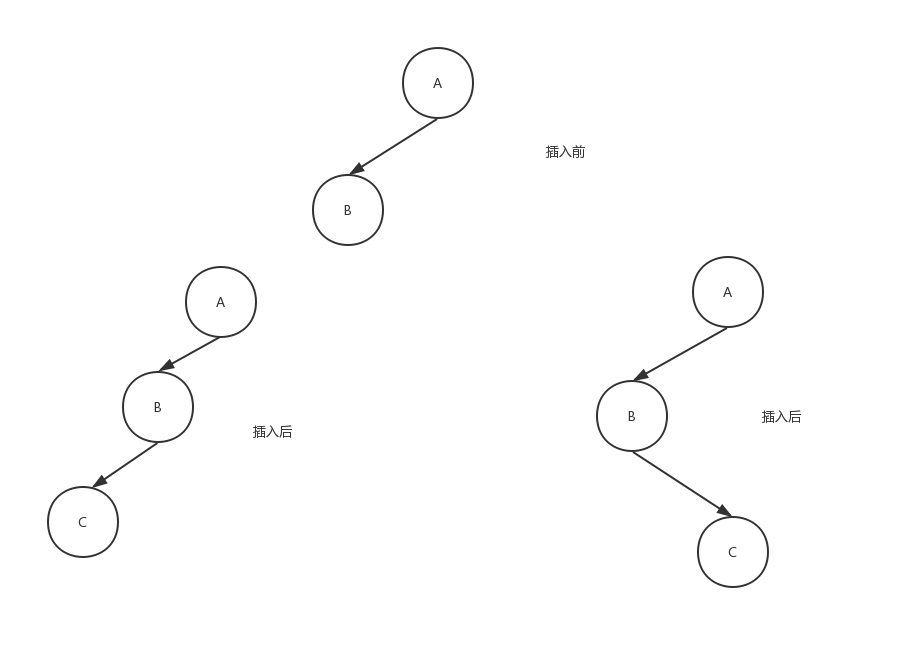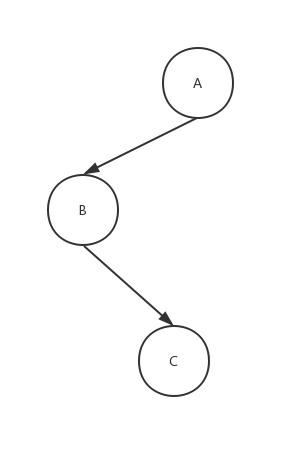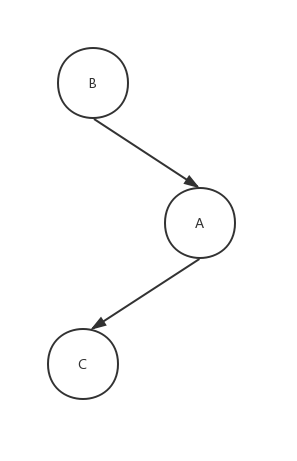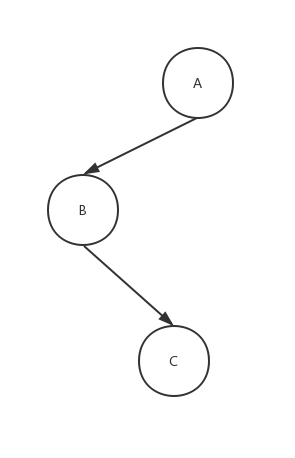AVL的定义
平衡二叉树:是一种特殊的二叉排序树,其中每一个节点的左子树和右子树的高度差至多等于1。从平衡二叉树的名字中可以看出来,它是一种高度平衡的二叉排序树。那么什么叫做高度平衡呢?意思就是要么它是一颗空树,要么它的左子树和右子树都是平衡二叉树,且左子树和右子树的深度只差的绝对值绝对不超过1。
平衡因子:将二叉树上节点的左子树深度减去右子树深度的值称为平衡因子BF。则平衡二叉树上所有节点的平衡因子只可能是1,-1,0。
只要二叉树上有一个节点的平衡因子的绝对值大于1,那么该二叉树就是不平衡的。
最小不平衡子树:距离插入节点最近的,且平衡因子的绝对值大于1的节点为根的子树,我们称之为最小不平衡子树。
平衡二叉树实现原理
平衡二叉树构建的基本思想就是在构建二叉排序树的过程中,每当插入一个节点时,先检查是否因插入而破坏了树的平衡性,若是,找出最小不平衡树。在保持二叉排序树特性的前提下,调整最小不平衡子树中各节点之间的链接关系,进行相应的旋转,使之成为新的平衡子树。
旋转操作:
- 右旋:最小不平衡子树的BF和它的子树BF符号相同且最小不平衡子树的BF大于0
- 左旋:最小不平衡子树的BF和它的子树BF符号相同且最小不平衡子树的BF小于零
- 左右旋:最小不平衡子树的BF与它的子树的BF符号相反时且最小不平衡子树的BF大于0时,需要对节点先进行一次向左旋使得符号相同后,在向右旋转一次完成平衡操作。
- 右左旋:最小不平衡子树的BF与它的子树的BF符号相反时且最小不平衡子树的BF小于0时,需要对节点先进行一次向右旋转使得符号相同时,在向左旋转一次完成平衡操作。
放一张自己理解的图:

平衡二叉树的构建
节点定义
平衡二叉树节点数据结构和二叉排序树相差不大:
public class AVLNode {
public AVLNode parent;
public AVLNode leftChild, rightChild;
public int data;
public AVLNode(AVLNode parent, AVLNode leftChild, AVLNode rightChild, int data) {
this.parent = parent;
this.leftChild = leftChild;
this.rightChild = rightChild;
this.data = data;
}
public AVLNode(int data) {
this(null, null, null, data);
}
public AVLNode(AVLNode parent, int data) {
this.parent = parent;
this.data = data;
}
}
插入节点
在进行插入时,我们需要考虑插入的这个节点会不会破坏二叉树的平衡,如果平衡被打破,那么我们需要考虑如何调整二叉树的结构使得平衡恢复。
我们以插入后左子树比右子树BF大2的所有情况举例,下面的图只是代表着那个被打破平衡的点的子树,并不代表整棵树。

这是第一种情况,其中A和B节点是平衡二叉树树中某一节点集合,现在插入C,可以从图上看到,要想打破平衡,节点C必须插入B上
第二种情况:

其中的A、B、C、D是平衡二叉树中某一节点集合,现在插入节点F,平衡被打破,那么F需要插入到D上才能打破平衡。
第三种情况:

其中A、B、C、D、E为平衡二叉树中某一节点集合,并不表示整棵树。现在插入F节点,平衡被打破,那么F只能插在D、E上。
通过观察发现第二、三中情况其实是第一种情况衍变而来,如分别在A节点和B节点上增加节点就变成了第二三中情况。
对于第一种情况进行研究:

要使A节点的BF小于2,我们需要对该节点集合的结构进行相应调整,根据二叉排序树的性质我们知道A节点的值一定比B节点大,而C节点的值一定比B节点的大,所以我们可以将B节点来替换A节点,让A节点做B节点的右孩子。若A节点有父节点,那么A的父节点的子节点要指向B节点,同时A节点的父节点为B,也就是进行右旋操作:

而对于第一种情况的这种图:

我们发现使用上面的逻辑好像并不能完成平衡,执行完之后是这样子的:

这样子根本没有平衡。所以不能仅旋转一次。我们发现对于A节点它的BF等于2,对于B节点它的BF值等于-1,符号相反,所以我们需要执行左右旋,先将最小不平衡子树和它的子树的BF符号相同,在进行平衡。
对于B节点执行左旋,那么C节点会变成A节点的左子节点,同时B节点会变成C节点的左子节点,这样就又回到了最初的情况:

在执行右旋,完成平衡化:
对于第二种情况和第三种情况实际上分析思路和第一种情况一样。
右旋代码:
/**
* 右旋
* @param node
* @return
*/
public AVLNode rightRotation(AVLNode node) {
if(node != null) {
AVLNode leftChild = node.leftChild;
node.leftChild = leftChild.rightChild;
// 如果leftChild的右节点存在,则需将该右节点的父节点指给node节点
if(leftChild.rightChild != null) {
leftChild.rightChild.parent = node;
}
leftChild.parent = node.parent;
if(node.parent == null) {
this.root = leftChild;
}
else if(node.parent.rightChild == node) { // 即node节点在它原父节点的右子树中
node.parent.rightChild = leftChild;
}
else if(node.parent.leftChild == node) {
node.parent.leftChild = leftChild;
}
leftChild.rightChild = node;
node.parent = leftChild;
return leftChild;
}
return null;
}
左旋代码:
/**
* 左旋
* @param node
* @return
*/
public AVLNode leftRotation(AVLNode node) {
if(node != null) {
AVLNode rightChild = node.rightChild;
node.rightChild = rightChild.leftChild;
if(rightChild.leftChild != null) {
rightChild.leftChild.parent = node;
}
rightChild.parent = node.parent;
if(node.parent == null) {
this.root = rightChild;
}
else if(node.parent.rightChild == node) {
node.parent.rightChild = rightChild;
}
else if(node.parent.leftChild == node) {
node.parent.leftChild = rightChild;
}
rightChild.leftChild = node;
node.parent = rightChild;
return rightChild;
}
return null;
}
那么现在有一个问题,怎么判别被打破的平衡要经历哪种操作才能达到平衡呢?
根据上面的原理,分为四种情况,这四种情况可以划分为两大类:
- 第一大类,A节点的左子树高度比右子树高度高2,最终需要经过右旋操作(可能需要先左后右)
- 第二大类,A节点的左子树高度比右子树高度低2,最终需要经过左旋操作(可能需要先右后左)
所以我们插入新节点的思路就是,在插入节点之后,判断插入的节点是在A的左子树还是右子树。
插入节点代码:
/**
* 插入节点
* @param data
*/
public void put(int data) {
putData(root, data);
}
private boolean putData(AVLNode node, int data) {
if(node == null) {
node = new AVLNode(data);
root = node;
return true;
}
int t;
AVLNode p;
AVLNode temp = node;
do {
p = temp;
t = temp.data - data;
if(t < 0) {
temp = temp.rightChild;
}
else if(t > 0) {
temp = temp.leftChild;
}
else {
return false;
}
} while(temp != null);
if(t < 0) {
p.rightChild = new AVLNode(p, data);
}
else if(t > 0) {
p.leftChild = new AVLNode(p, data);
}
rebuild(p); //平衡二叉树的方法
return true;
}
对于rebuild()方法:
/**
* 平衡二叉树的方法
* @param node
*/
public void rebuild(AVLNode node) {
while(node != null) {
if(calcNodeBalanceValue(node) == MAX_LEFT) { //左子树高
fixAfterInsertion(node, LEFT);
}
else if(calcNodeBalanceValue(node) == MAX_RIGHT) { //右子树高
fixAfterInsertion(node, RIGHT);
}
node = node.parent;
}
}
这段代码从插入节点的父节点开始,向上回朔的去查找失去平衡的节点,通过calcNodeBalanceValue()方法来结算当前节点的左右子树高度差,判断是2(MAX_LEFT)还是-2(MAX_RIGHT)。
计算节点BF的相应方法:
/**
* 计算node节点的BF值
* @param node
* @return
*/
public int calcNodeBalanceValue(AVLNode node) {
if(node != null) {
return getHeightByNode(node);
}
return 0;
}
private int getHeightByNode(AVLNode node) {
if(node == null) {
return 0;
}
return getChildDepth(node.leftChild) - getChildDepth(node.rightChild);
}
private int getChildDepth(AVLNode node) {
if(node == null) {
return 0;
}
return 1 + Math.max(getChildDepth(node.leftChild), getChildDepth(node.rightChild));
}
在找到相应的类型后,执行fixAfterInsertion()来完成对不同类型的调整方法。
/**
* 调整树的结构
* @param node
* @param type
*/
public void fixAfterInsertion(AVLNode node, int type) {
if(type == LEFT) {
AVLNode leftChild = node.leftChild;
if(leftChild.leftChild != null) { //右旋
rightRotation(node);
}
else if(leftChild.rightChild != null) { //左右旋
leftRotation(leftChild);
rightRotation(node);
}
}
else if(type == RIGHT) {
AVLNode rightChild = node.rightChild;
if(rightChild.rightChild != null) { //左旋
leftRotation(node);
}
else if(rightChild.leftChild != null) { //右左旋
rightRotation(rightChild);
leftRotation(node);
}
}
}
根据我参考其他博主的想法,通过左右子树是否为空的判断来决定它是单旋还是双旋,原因:如果代码执行到了这个方法,那么肯定平衡被打破了,就暂且拿第一个大类来说 ,A的左子树高度要比右子树高2,意味平衡被打破了,再去结合上面分析的第一种情况,当插入元素后树结构是以下结构,那肯定是单旋。

如果是以下结构,那肯定是这种结构,由上面分析,这种结构必须的双旋。

所以,这里是根据插入的节点是位于B节点的左右方来决定是单旋还是双旋(在这里,不保证结论完全正确,若有错误,还望大家指正)。
以上是对平衡二叉树的插入操作和平衡话操作。
中序遍历:
对于平衡二叉树和二叉排序树的遍历是相同的,因为平衡二叉树就是一个特殊的二叉排序树。
/**
* 中序遍历
*/
public void middOrderErgodic() {
this.middOrderErgodic(this.root);
}
public void middOrderErgodic(AVLNode node) {
if(node != null) {
this.middOrderErgodic(node.leftChild);
System.out.print(node.data + ", ");
this.middOrderErgodic(node.rightChild);
}
}
根据key值获得指定的节点:
/**
* 获得指定节点
* @param key
* @return
*/
public AVLNode getNode(int key) {
AVLNode node = root;
int t;
do {
t = node.data - key;
if(t > 0) {
node = node.leftChild;
}
else if(t < 0) {
node = node.rightChild;
}
else {
return node;
}
} while(node != null);
return null;
}
对平衡二叉树进行层序遍历:
/**
* 层序遍历
*/
public void sequenceErgodic() {
if(this.root == null) {
return;
}
Queue<AVLNode> queue = new LinkedList<>();
AVLNode temp = null;
queue.add(this.root);
while(!queue.isEmpty()) {
temp = queue.poll();
System.out.println("当前节点值:" + temp.data + ", BF:" + calcNodeBalanceValue(temp));
if(temp.leftChild != null) {
queue.add(temp.leftChild);
}
if(temp.rightChild != null) {
queue.add(temp.rightChild);
}
}
}
采用队列,将一层所有的节点保存在一个队列中,并按序输出。
获得平衡二叉树指定节点的后继:
/***
* 获得指定节点的后继
* 找到node节点的后继节点
* 1、先判断该节点有没有右子树,如果有,则从右节点的左子树中寻找后继节点,没有则进行下一步
* 2、查找该节点的父节点,若该父节点的右节点等于该节点,则继续寻找父节点,
* 直至父节点为Null或找到不等于该节点的右节点。
* 理由:
* 后继节点一定比该节点大,若存在右子树,则后继节点一定存在右子树中,这是第一步的理由
* 若不存在右子树,则也可能存在该节点的某个祖父节点(即该节点的父节点,或更上层父节点)的右子树中,
* 对其迭代查找,若有,则返回该节点,没有则返回null
* @param node
* @return
*/
public AVLNode getSuccessor(AVLNode node) {
if(node.rightChild != null) {
AVLNode rightChild= node.rightChild;
while(rightChild.leftChild != null) {
rightChild = rightChild.leftChild;
}
return rightChild;
}
AVLNode parent = node.parent;
while(parent != null && (node == parent.rightChild)) {
node = parent;
parent = parent.parent;
}
return parent;
}
这里的思想我也是看了半天,首先我们对于节点后继应该是在该节点右子树中最小的值,但是因为在插入时结构进行了调整,节点后继不在该节点右子树中,那么这时应该查找该节点的父节点,若该父节点的右节点等于该节点,则继续寻找父节点,直至父节点为Null或找到不等于该节点的右节点。
删除节点
要注意的是,需要删除节点后的二叉树检测是否有平衡打破的问题,如果平衡被打破,应该重新跳转当前二叉树结构,以恢复平衡化
/**
* 删除指定val值的节点
* @param val
* @return
*/
public boolean delete(int val) {
AVLNode node = getNode(val);
if(node == null) {
return false;
}
boolean flag = false;
AVLNode p = null;
AVLNode parent = node.parent;
AVLNode leftChild = node.leftChild;
AVLNode rightChild = node.rightChild;
if(leftChild == null && rightChild == null) {
if(parent != null) {
if(parent.leftChild == node) {
parent.leftChild = null;
}
else if(parent.rightChild == node) {
parent.rightChild = null;
}
}
else {
this.root = null;
}
p = parent;
node = null;
flag = true;
}
else if(leftChild == null && rightChild != null) {
if(parent != null && parent.data > val) {
parent.leftChild = rightChild;
}
else if(parent != null && parent.data < val) {
parent.rightChild = rightChild;
}
else {
this.root = rightChild;
}
p = parent;
node = null;
flag = true;
}
else if(leftChild != null && rightChild == null) {
if(parent != null && parent.data > val) {
parent.leftChild = leftChild;
}
else if(parent != null && parent.data < val) {
parent.rightChild = leftChild;
}
else {
this.root = leftChild;
}
p = parent;
node = null;
flag = true;
}
else if(leftChild != null && rightChild != null) {
AVLNode successor = getSuccessor(node);
int tempData = successor.data;
if(delete(tempData)) {
node.data = tempData;
}
p = successor;
successor = null;
flag = true;
}
if(flag) {
this.rebuild(p);
}
return flag;
}
完整代码
package 平衡二叉树;
import java.util.LinkedList;
import java.util.Queue;
public class MyAVLTree {
private AVLNode root;
private final int LEFT = 1;
private final int RIGHT = -1;
private final int MAX_LEFT = 2;
private final int MAX_RIGHT = -2;
/**
* 插入节点
* @param data
*/
public void put(int data) {
putData(root, data);
}
private boolean putData(AVLNode node, int data) {
if(node == null) {
node = new AVLNode(data);
root = node;
return true;
}
int t;
AVLNode p;
AVLNode temp = node;
do {
p = temp;
t = temp.data - data;
if(t < 0) {
temp = temp.rightChild;
}
else if(t > 0) {
temp = temp.leftChild;
}
else {
return false;
}
} while(temp != null);
if(t < 0) {
p.rightChild = new AVLNode(p, data);
}
else if(t > 0) {
p.leftChild = new AVLNode(p, data);
}
rebuild(p);
return true;
}
/**
* 平衡二叉树的方法
* @param node
*/
public void rebuild(AVLNode node) {
while(node != null) {
if(calcNodeBalanceValue(node) == MAX_LEFT) {
fixAfterInsertion(node, LEFT);
}
else if(calcNodeBalanceValue(node) == MAX_RIGHT) {
fixAfterInsertion(node, RIGHT);
}
node = node.parent;
}
}
/**
* 调整树的结构
* @param node
* @param type
*/
public void fixAfterInsertion(AVLNode node, int type) {
if(type == LEFT) {
AVLNode leftChild = node.leftChild;
if(leftChild.leftChild != null) { //右旋
rightRotation(node);
}
else if(leftChild.rightChild != null) { //左右旋
leftRotation(leftChild);
rightRotation(node);
}
}
else if(type == RIGHT) {
AVLNode rightChild = node.rightChild;
if(rightChild.rightChild != null) { //左旋
leftRotation(node);
}
else if(rightChild.leftChild != null) { //右左旋
rightRotation(rightChild);
leftRotation(node);
}
}
}
/**
* 右旋
* @param node
* @return
*/
public AVLNode rightRotation(AVLNode node) {
if(node != null) {
AVLNode leftChild = node.leftChild;
node.leftChild = leftChild.rightChild;
// 如果leftChild的右节点存在,则需将该右节点的父节点指给node节点
if(leftChild.rightChild != null) {
leftChild.rightChild.parent = node;
}
leftChild.parent = node.parent;
if(node.parent == null) {
this.root = leftChild;
}
else if(node.parent.rightChild == node) { // 即node节点在它原父节点的右子树中
node.parent.rightChild = leftChild;
}
else if(node.parent.leftChild == node) {
node.parent.leftChild = leftChild;
}
leftChild.rightChild = node;
node.parent = leftChild;
return leftChild;
}
return null;
}
/**
* 左旋
* @param node
* @return
*/
public AVLNode leftRotation(AVLNode node) {
if(node != null) {
AVLNode rightChild = node.rightChild;
node.rightChild = rightChild.leftChild;
if(rightChild.leftChild != null) {
rightChild.leftChild.parent = node;
}
rightChild.parent = node.parent;
if(node.parent == null) {
this.root = rightChild;
}
else if(node.parent.rightChild == node) {
node.parent.rightChild = rightChild;
}
else if(node.parent.leftChild == node) {
node.parent.leftChild = rightChild;
}
rightChild.leftChild = node;
node.parent = rightChild;
return rightChild;
}
return null;
}
/**
* 计算node节点的BF值
* @param node
* @return
*/
public int calcNodeBalanceValue(AVLNode node) {
if(node != null) {
return getHeightByNode(node);
}
return 0;
}
private int getHeightByNode(AVLNode node) {
if(node == null) {
return 0;
}
return getChildDepth(node.leftChild) - getChildDepth(node.rightChild);
}
private int getChildDepth(AVLNode node) {
if(node == null) {
return 0;
}
return 1 + Math.max(getChildDepth(node.leftChild), getChildDepth(node.rightChild));
}
/**
* 中序遍历
*/
public void middOrderErgodic() {
this.middOrderErgodic(this.root);
}
public void middOrderErgodic(AVLNode node) {
if(node != null) {
this.middOrderErgodic(node.leftChild);
System.out.print(node.data + ", ");
this.middOrderErgodic(node.rightChild);
}
}
/**
* 删除指定val值的节点
* @param val
* @return
*/
public boolean delete(int val) {
AVLNode node = getNode(val);
if(node == null) {
return false;
}
boolean flag = false;
AVLNode p = null;
AVLNode parent = node.parent;
AVLNode leftChild = node.leftChild;
AVLNode rightChild = node.rightChild;
if(leftChild == null && rightChild == null) {
if(parent != null) {
if(parent.leftChild == node) {
parent.leftChild = null;
}
else if(parent.rightChild == node) {
parent.rightChild = null;
}
}
else {
this.root = null;
}
p = parent;
node = null;
flag = true;
}
else if(leftChild == null && rightChild != null) {
if(parent != null && parent.data > val) {
parent.leftChild = rightChild;
}
else if(parent != null && parent.data < val) {
parent.rightChild = rightChild;
}
else {
this.root = rightChild;
}
p = parent;
node = null;
flag = true;
}
else if(leftChild != null && rightChild == null) {
if(parent != null && parent.data > val) {
parent.leftChild = leftChild;
}
else if(parent != null && parent.data < val) {
parent.rightChild = leftChild;
}
else {
this.root = leftChild;
}
p = parent;
node = null;
flag = true;
}
else if(leftChild != null && rightChild != null) {
AVLNode successor = getSuccessor(node);
int tempData = successor.data;
if(delete(tempData)) {
node.data = tempData;
}
p = successor;
successor = null;
flag = true;
}
if(flag) {
this.rebuild(p);
}
return flag;
}
/**
* 获得指定节点
* @param key
* @return
*/
public AVLNode getNode(int key) {
AVLNode node = root;
int t;
do {
t = node.data - key;
if(t > 0) {
node = node.leftChild;
}
else if(t < 0) {
node = node.rightChild;
}
else {
return node;
}
} while(node != null);
return null;
}
/***
* 获得指定节点的后继
* 找到node节点的后继节点
* 1、先判断该节点有没有右子树,如果有,则从右节点的左子树中寻找后继节点,没有则进行下一步
* 2、查找该节点的父节点,若该父节点的右节点等于该节点,则继续寻找父节点,
* 直至父节点为Null或找到不等于该节点的右节点。
* 理由,后继节点一定比该节点大,若存在右子树,则后继节点一定存在右子树中,这是第一步的理由
* 若不存在右子树,则也可能存在该节点的某个祖父节点(即该节点的父节点,或更上层父节点)的右子树中,
* 对其迭代查找,若有,则返回该节点,没有则返回null
* @param node
* @return
*/
public AVLNode getSuccessor(AVLNode node) {
if(node.rightChild != null) {
AVLNode rightChild= node.rightChild;
while(rightChild.leftChild != null) {
rightChild = rightChild.leftChild;
}
return rightChild;
}
AVLNode parent = node.parent;
while(parent != null && (node == parent.rightChild)) {
node = parent;
parent = parent.parent;
}
return parent;
}
/**
* 层序遍历
*/
public void sequenceErgodic() {
if(this.root == null) {
return;
}
Queue<AVLNode> queue = new LinkedList<>();
AVLNode temp = null;
queue.add(this.root);
while(!queue.isEmpty()) {
temp = queue.poll();
System.out.println("当前节点值:" + temp.data + ", BF:" + calcNodeBalanceValue(temp));
if(temp.leftChild != null) {
queue.add(temp.leftChild);
}
if(temp.rightChild != null) {
queue.add(temp.rightChild);
}
}
}
public static void main(String[] args) {
MyAVLTree bbt = new MyAVLTree();
bbt.put(3);
bbt.put(2);
bbt.put(1);
bbt.put(4);
bbt.put(5);
bbt.put(6);
bbt.put(7);
bbt.put(10);
bbt.put(9);
bbt.middOrderErgodic();
System.out.println();
System.out.println("-----各节点平衡状况-----");
bbt.sequenceErgodic();
System.out.println();
bbt.delete(5);
bbt.delete(2);
bbt.middOrderErgodic();
System.out.println();
System.out.println("-----各节点平衡状况-----");
bbt.sequenceErgodic();
System.out.println();
}
}
参考:
《大话数据结构》
https://www.cnblogs.com/qm-article/p/9349681.html
https://www.cnblogs.com/zhangbaochong/p/5164994.html